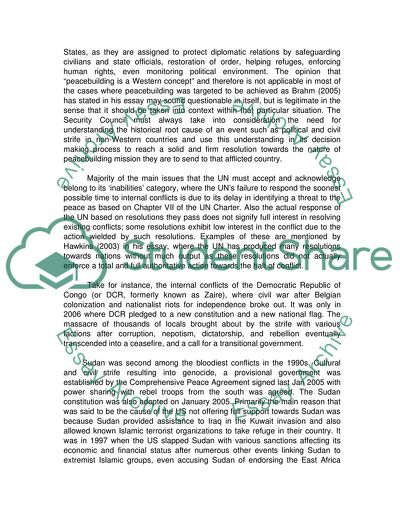
- Home
- Free Samples
- Premium Essays
- Editing Services
- Extra Tools
- Essay Writing Help
- About Us
- Studentshare
- Subjects
- Miscellaneous
- UN and Internal conflicts of the 1990s
UN and Internal conflicts of the 1990s - Essay Example

- Subject: Miscellaneous
- Type: Essay
- Level: Undergraduate
- Pages: 4 (1000 words)
- Downloads: 0
- Author: hamillolaf
Extract of sample "UN and Internal conflicts of the 1990s"
ost widely known internal conflicts included Iraq-Kuwait (demilitarization), Angola (peace accord implementation), Cambodia (UNTAC), Yugoslavia/Kosovo (relief), Somalia (ceasefire civil war, relief), Uganda-Rwanda (border), Haiti (transition, institution), and East Timor (independence transition). Mostly those that have undergone civil strife within the warring factions in the local communities were given humanitarian relief instead of striving towards the achievement of peace through peacekeeping and peacebuilding missions, especially due to ethnic and cultural conflicts.
Brahm (2005) mentions that the lack of central authority in nations that experienced tragic deaths due to ethnic and cultural conflicts makes it difficult for the UN to act, when it is in fact the UN that should already serve as the main central authority. Brahm also cites that the UN is known to act towards existing crises, not preventing them. He continues to note that although the UN Secretary-General at the time of post by Boutros Boutros-Ghali and Kofi Annan was effective in extending a diplomatic hand in negotiations and interventions without the requirement of the Security Council’s go-signal, it is still the Security Council who is main executor of resolutions and actions that will pursue missions.
The commitment value of the Member States in assuring thorough relief and support in aiding the nations involved with civil strife based on political and cultural differences, according to Brahm, is way low, and primarily the difficulties lie in the finger-pointing of who will provide continuous advocacy that will eventually help these said afflicted nations towards their own deliverance. In this we agree. Most of the times the UN has been seen to act based on the individual interests of the Member States, and if it is something that does not involve their nation’s benefiting from such a situation, it is most likely that they are not as keen to offer sincere assistance.
Still, there have
...Download file to see next pages Read MoreCHECK THESE SAMPLES OF UN and Internal conflicts of the 1990s
The Depression of the 1930s
Drivers for Current Immigration-Emigration Patterns in Sudan
American Gangster Film
The Impact of Internal Conflicts on World Politics
The Most Significant Events in the Decades Following World War II
Did Lebanon Fall Apart In the 1970s and 1980s because of the Arab-Israeli Conflict
Personal Nursing Philosophy
Discuss a contemporary problem in penolog

- TERMS & CONDITIONS
- PRIVACY POLICY
- COOKIES POLICY